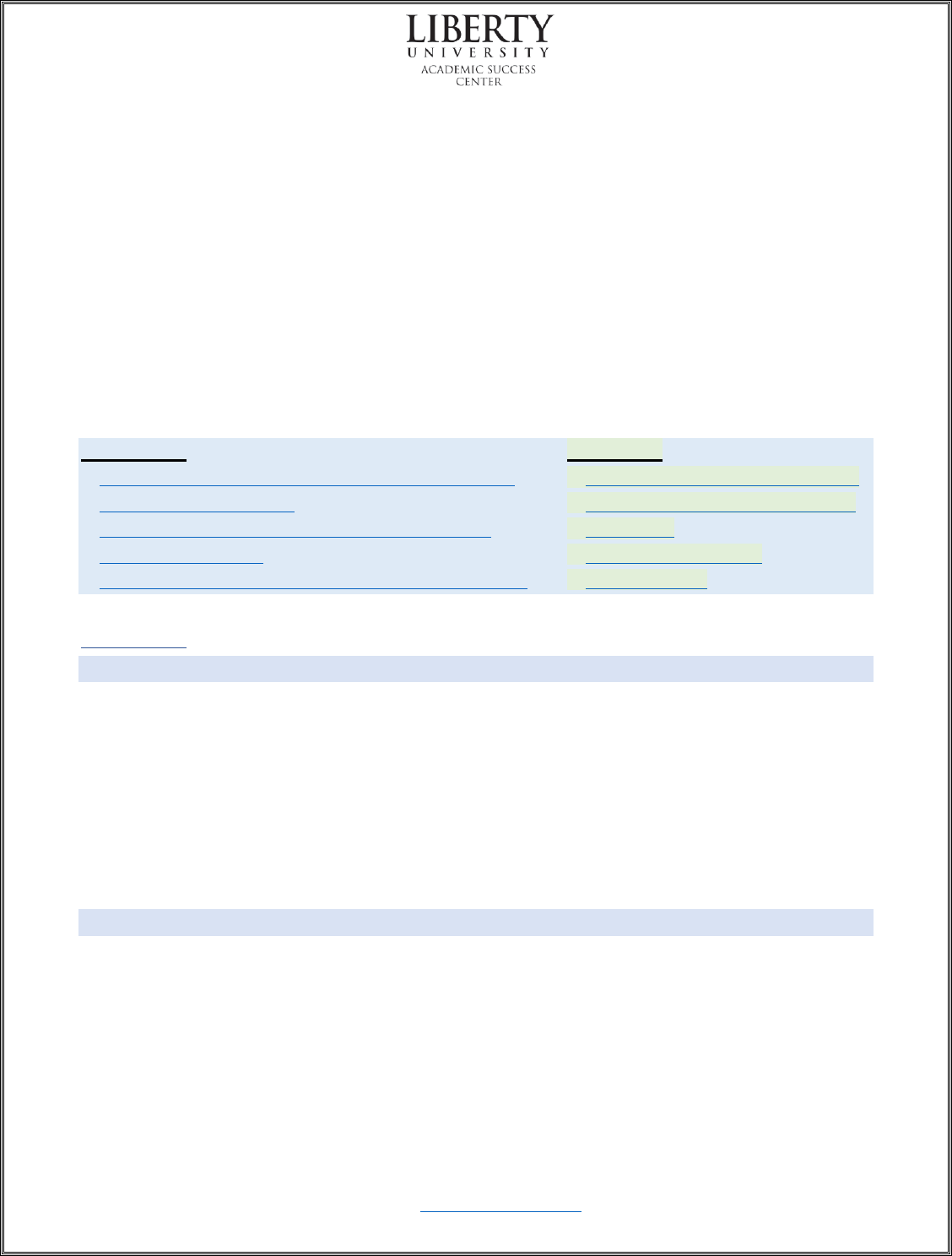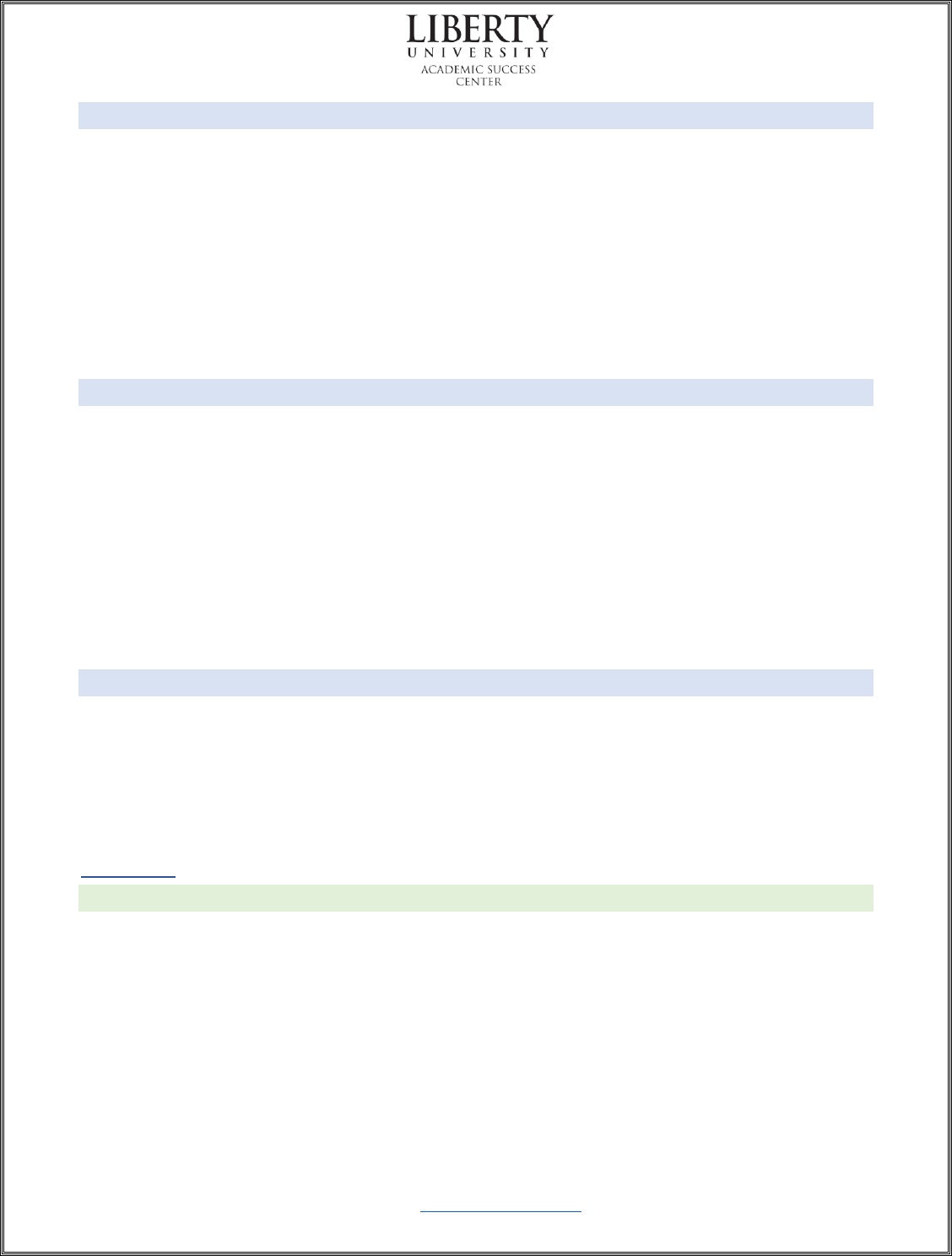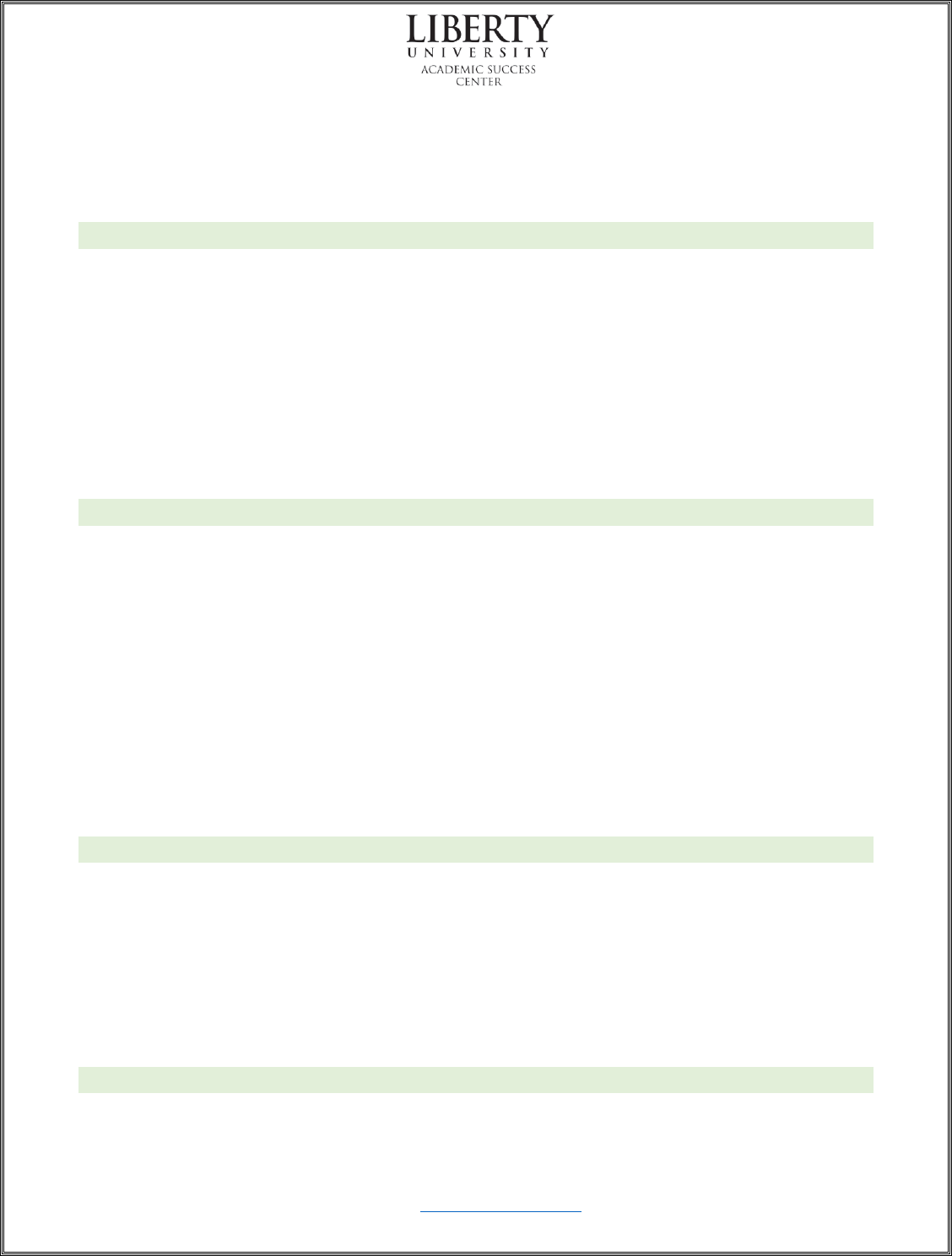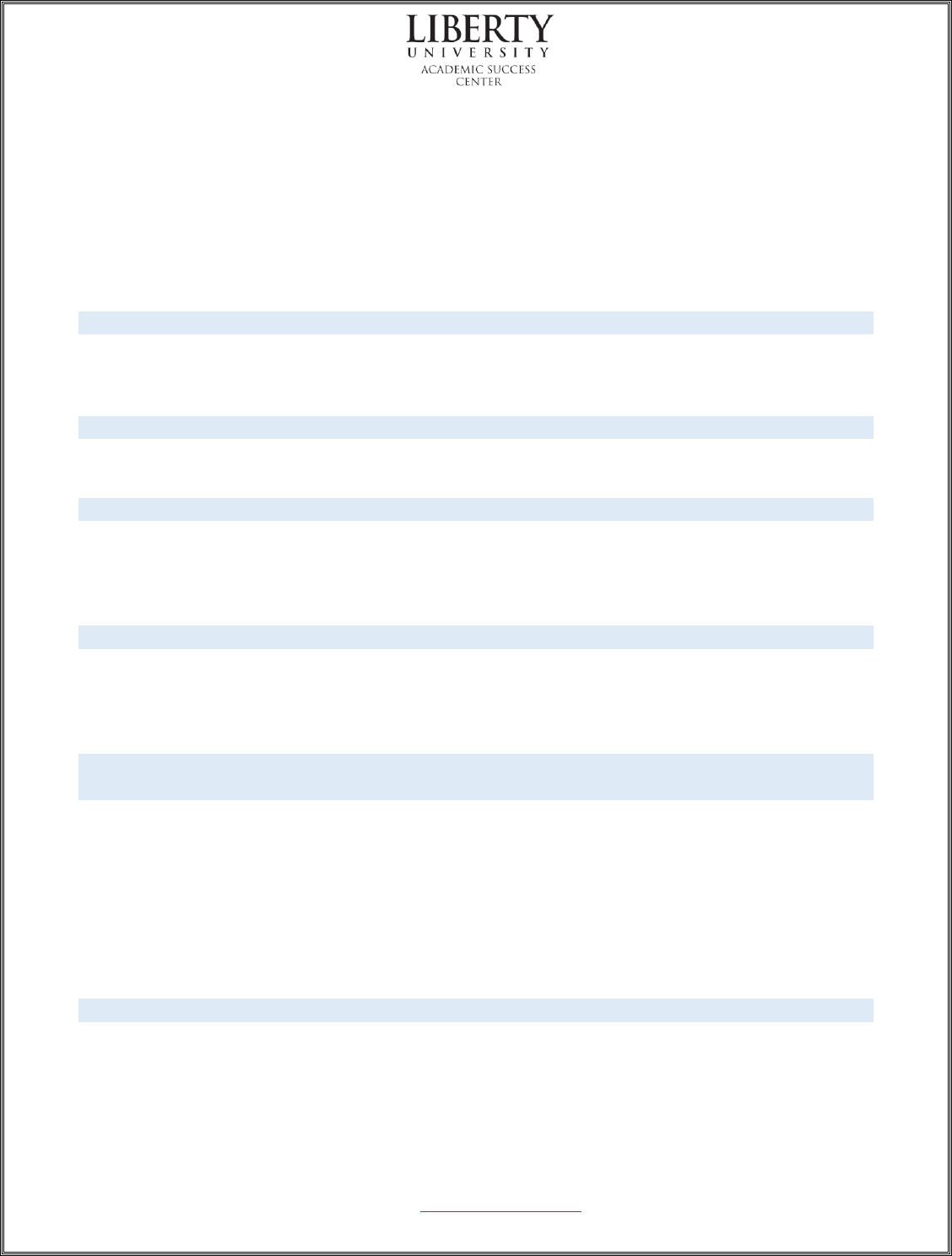
1
by Jeff Valerioti, ©2022, Liberty University Online Writing Center
E-mail: [email protected]
Comma Usage
The primary function of punctuation serves to bring clarity and precise meaning to
sentences. Punctuation also has a rhetorical function, which is especially true of the comma. A
comma can be used to indicate the degree of pause required to bring emphasis or contrast to the
writer’s intended meaning in a sentence. This secondary function can sometimes lead to overuse,
or even misuse, of the comma when placing it based on a perceived need to pause in the
sentence. An improperly placed comma can alter a sentence’s meaning. To guide the reader
toward clearer understanding of the intended message, the writer must place commas based on
the generally accepted rules of comma usage in formal writing, rather than according to what
“sounds right.” These rules can be divided into two broad categories based upon the comma’s
purpose in a sentence, whether to separate or to enclose.
To Separate To Enclose
1. Independent clauses joined by coordinating conjunction 1. Nonrestrictive (nonessential) clauses
2. Elements in a series (lists) 2. Parenthetical elements (interrupters)
3. Two or more coordinate adjectives preceding a noun 3. Appositives
4. Introductory elements 4. Words in direct address
5. Conventional uses: Dates, addresses, salutations, closings 5. Dialogue guides
To Separate
1. Independent clauses joined by coordinating conjunction
A comma is generally used to separate independent clauses joined by a coordinating conjunction
(and, but, for, or, nor) in a compound sentence. The comma is placed before the conjunction,
though the writer may choose to omit the comma in sentences where the clauses are brief and
closely related in meaning.
Examples: The first two acts of the play were tedious, but the third act was suspenseful and left
the audience completely surprised.
Students went ahead and faculty followed later. (short independent clauses where
comma is not required)
2. Elements in a series (lists)
Commas are used to separate three or more words, phrases, or clauses in a series. Usually, the
last item in the series is joined to the others by and or or, though the final comma (referred to as
the Oxford comma) is sometimes omitted in less formal writing, provided the clarity or intended
meaning of the sentence is not harmed.
Examples: Dr. Evans was formerly a tenured professor at universities located in London, Boston,
and New York.
The committee had to decide whether to distribute winter coats for children, shoes for
teens, or towels and linens before the next meeting.

2
by Jeff Valerioti, ©2022, Liberty University Online Writing Center
E-mail: [email protected]
3. Two or more coordinate adjectives preceding a noun
When two or more consecutive adjectives precede a noun, commas are used to separate them if
each of the adjectives refers independently to that same noun (e.g. slim, gleaming skyscraper).
Alternatively, a comma would not be used if one of the adjectives serves to modify the other
adjective (e.g., tiny red spots). If unsure about placement of the comma between adjectives,
substitute “and” in place of the comma to assess clarity. The comma is required if the intended
meaning is clear with the use of “and” in its place.
Examples: The audience cheered the brilliant, flawless performance of Beethoven’s final work.
Kevin wore a bright green blazer to the concert. (no comma required since “bright”
modifies “green”)
4. Introductory elements
Words, phrases, and clauses that are placed at the beginning of the main clause serve as
introductory elements of the sentence. Commas are used to set off these non-restrictive modifiers
and serve to improve the fluency and clarity of the sentence, especially when the introductory
element is lengthy. Length alone does not determine whether a comma is placed after an
introductory element, as shorter phrases and certain words (yes, no, why, well, etc.) are often set
off by commas for emphasis or greater clarity.
Examples: At the edge of the forest near the lake, the campers set up their tent for the night.
Yes, certain bacteria can be cultured in the lab for purposes of the experiment.
As an example, younger children will often imitate the actions of older siblings.
5. Conventional uses
Commas are used to separate items in dates, addresses, and after salutations of friendly letters
and closings of all letters. (Note: Colons are used following the salutations of professional letters
and business correspondence.)
Examples: January 1, 2023
Dear Professor Taylor,
Sincerely,
To Enclose
1. Nonrestrictive (nonessential) clauses
A nonrestrictive clause refers to a subordinate clause that is not essential to the meaning of the
sentence but adds an idea or additional information to it. Commas are used to set off such clauses
from the main sentence, since these nonessential clauses do not impact the central meaning of the
sentence. Restrictive (essential) clauses do not require commas, as they are considered necessary
in the sentence to communicate its intended meaning. Without these restrictive clauses, the
sentence would mean something else; therefore, no commas are needed. If unsure whether or not
to set off a clause with commas, the following exercise that is often shared with students by LU
professor Dr. Shelah Simpson will help confirm the placement or omission of the commas: With
your index fingers representing the commas surrounding a clause, imagine lifting the clause from
the sentence. If the sentence still makes sense, then the commas are needed; however, if the
meaning is harmed, then do not enclose the clause with commas.

3
by Jeff Valerioti, ©2022, Liberty University Online Writing Center
E-mail: [email protected]
Examples: The class valedictorian, who was offered full scholarships to four universities, has not
yet decided where she will attend in the fall. (nonessential clause requiring commas)
The class valedictorian is the only senior who was offered full scholarships to four
universities. (essential clause where no comma is needed)
2. Parenthetical elements (interrupters)
When sentence elements tend to break or interrupt the flow of a sentence, they are referred to as
interrupters. Such words, phrases, and parenthetical clauses require commas to set off the
elements to preserve the clarity of the sentence. Parenthetical expressions (of course, for
example, on the contrary, nevertheless, therefore, etc.) are often used for emphasis or to
highlight distinctions and must be set off by commas.
Examples: The weighting of the rubric element, of course, determines the grade on the
assignment.
Boaters are encouraged, even when official storm warnings expire, to have guests
wearing life preservers.
3. Appositives
A specific type of interrupter, an appositive is a word following a noun or pronoun that serves to
identify, explain, qualify, or emphasize the meaning of the noun/pronoun it follows. (An
appositive phrase consists of an appositive and its modifiers.) Appositives are usually set off by
commas, unless the appositive is so closely related to the word it modifies that it appears to be
part of that word. This type of appositive is known as a restrictive appositive and does not
require a comma.
Examples: Katherine and Paul, landowners, sought to change the zoning ordinances in order to
develop the adjacent properties.
To promote their latest releases, Peretti and Dekker, best-selling authors, will be
hosting a book-signing event in New York City.
The conjunction and is considered a coordinating conjunction. (restrictive appositive)
4. Words in direct address
Generally applied in direct quotes of dialogue, commas are used to set off names of individuals
or groups who are being specifically addressed as the intended receivers of the message. Words
used in direct address can be proper nouns, titles, group terms, or pronouns.
Examples: “Professor Ellis, the research seems to contradict my thesis,” responded the student
when asked for a status report.
Please read the instructions carefully, my dear students, in order to meet all course
requirements.
5. Dialogue guides
Explanatory clauses, such as she said or they stated, are referred to as dialogue guides, since they
serve the purpose of guiding the reader as to the source of the quoted material. Commas are
needed to set off these clauses when they are inserted within the direct quote.

4
by Jeff Valerioti, ©2022, Liberty University Online Writing Center
E-mail: [email protected]
Examples: “The greatest success rate,” stated the researchers, “was achieved by those students
who demonstrated excellent time management skills.”
Authors Stein and Corbin concluded, “More citizens have expressed opposition to the
proposed legislation following recent interest rate hikes.”
Common Misplacements
Proofread carefully to catch these common misuses of commas.
Using a comma to join two brief sentences that are related (referred to as a comma splice)
• Incorrect: Pam searched the entire library, the book was nowhere to be found.
✓ Correct: Pam searched the entire library; the book was nowhere to be found.
✓ Correct: Pam searched the entire library, but the book was nowhere to be found.
Placing a comma before a restrictive (essential) clause
• Incorrect: The hiring manager chose another applicant, who had far more experience.
✓ Correct: The hiring manager chose another applicant who had far more experience.
Enclosing essential clauses and phrases with commas
• Incorrect: The research scientist, who discovers a cure for Alzheimer’s disease, will
certainly win the Nobel Prize.
✓ Correct: The research scientist who discovers a cure for Alzheimer’s disease will
certainly win the Nobel Prize.
Inserting the comma after a conjunction in a compound sentence
• Incorrect: The championship game was rescheduled to Sunday because, the weather
service predicted hail for Saturday morning.
✓ Correct: The championship game was rescheduled to Sunday, because the weather
service predicted hail for Saturday morning.
Using a comma after a complete sentence, rather than a colon, or a comma after “that” to
introduce a direct quotation
• Incorrect: Researchers shared a critical observation from their study, “Prolonged use of
aspirin resulted in stomach inflammation among 63% of participants.”
✓ Correct: Researchers shared a critical observation from their study: “Prolonged use of
aspirin resulted in stomach inflammation among 63% of participants.”
• Incorrect: Independent accounting firms both reported that, “Nearly half of the cars tested
were found to have false data recorded during emissions testing.”
✓ Correct: Independent accounting firms both reported that “Nearly half of the cars tested
were found to have false data recorded during emissions testing.”
Using a comma to separate a verb from its subject
• Incorrect: One of the best writing skills a writer can have, is investing time in careful
proofreading.
✓ Correct: One of the best writing skills a writer can have is investing time in careful
proofreading.

5
by Jeff Valerioti, ©2022, Liberty University Online Writing Center
E-mail: [email protected]
Using commas to separating verbs that share the same subject
• Incorrect: The lacrosse team ran for 30 minutes, and practiced for 60 minutes.
✓ Correct: The lacrosse team ran for 30 minutes and practiced for 60 minutes.
Using commas instead of semicolons in complex series where list elements already contain
commas
• Incorrect: Financial experts predict new lending offices will open in Sydney, Australia,
Stockholm, Sweden, and Montreal, Canada.
✓ Correct: Financial experts predict new lending offices will open in Sydney, Australia;
Stockholm, Sweden; and Montreal, Canada.
Practice
The following sentences may or may not require commas. Apply the comma usage rules and
identify those words in each sentence after which commas are needed. Indicate if no commas are
required in a sentence by labeling the corresponding number with “NC.”
1. The missions team installed a new gymnasium floor an improved heating system and
whiteboards in the school building.
2. Animals frightened by thunder often try to hide.
3. The massive crowd scattered dispersing rapidly in all directions.
4. Having studied the tax proposals of both committees the governors from Ohio and Illinois who
were both visibly upset rejected both proposals and then presented new plans.
5. Playhouses and theaters are experiencing increased ticket sales again but the New York City
theater district is seeing the largest revenue growth.
6. John’s cousin Susan was awarded a full scholarship to study art in Paris.
7. The authors of this journal article a stinging critique of democracy have in my opinion been
most unfair.
8. The college president’s daughter who was the youngest of seven children was married on
Saturday February 15 2020 which happened to be the coldest day on record in Boston
Massachusetts.
9. In the spirit of fairness and free enterprise the president of Argentina proposed a new trade
agreement that would of course benefit both countries while also reducing import taxes.
10. The jury patiently listened to more than six hours of complicated scientific expert testimony.
11. Each debate team delivered several strong arguments but failed to provide enough evidence
to support them.
12. Two manufacturing companies which happen to be family-owned businesses will be
proposing a new assembly plant one that will create hundreds of assembly administrative and
executive jobs in the region.

6
by Jeff Valerioti, ©2022, Liberty University Online Writing Center
E-mail: [email protected]
13. Soon after the doors opened writers flooded the auditorium to hear advice from the famous
author and they were not disappointed when the author began reading from her latest
unpublished manuscript.
14. In a recent medical study of cardiac stress researchers at Johns Hopkins stated “When
patients experience increased anxiety heart rates accelerate by more than 30%.”
15. When frustration reaches a certain level oppressed people demand to be heard and the
resulting reforms bring about freedom.
Answers: 1. floor, system, 2. NC (essential clause) 3. scattered, 4. committees, Illinois, upset, 5. again,
6. NC (closely related, single-word appositive) 7. article, democracy, have, opinion, 8. daughter, children,
Saturday, 15, 2020, Boston, 9. enterprise, would, course, countries, 10. complicated, scientific,
11. NC (The conjunction joins verbs rather than two independent clauses.) 12. companies, businesses, plant,
assembly, administrative, 13. opened, author, 14. stress, stated, anxiety, 15. level, heard,
Please note that this document and any footnoted or parenthetical reference entries of source material are not formatted according to a specific writing style. Citations, reference
entries, or MS Word settings should not be duplicated for use in academic submissions. Refer to your discipline’s particular writing style guidelines to comply with requirements.
